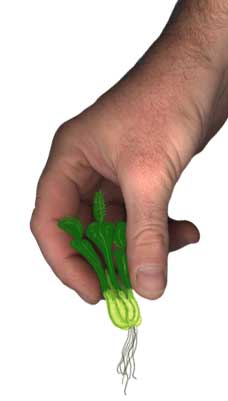
Caring for the Venus' Fly Trap - Dionaea muscipula.
This amazing plant is native to a small region in the Carolinas. Insects are trapped and digested by the plant to obtain nutrients; they are carnivorous plants. There are six small trigger hairs inside each trap. One hair touched twice, or two hairs touched once, signals the trap to snap shut. Empty traps reopen in a day or so. Traps with prey remain closed for a week or two. Then, the trap will reopen exposing the dry shell of the victim. Flytraps do not need regular feeding and can go long periods without insects. If you are growing them in a condition where no insects can get caught, such as a cool greenhouse, feeding one trap a small insect every couple months is probably beneficial.
Care: Venus' Fly Traps are perennials that form bulbs. They are winter hardy from about Maryland, southward. If you plan on growing the plant outdoors in this region, sink the pot or container in the ground to help prevent rapid temperature fluctuations. A winter layer of pine needle mulch, three inches deep, may help in areas that are borderline for hardiness. North of zone 7, keep the flytraps protected from deep freeze during the winter. A cool window, garage, root cellar, or basement can work. Winter storage temperatures should range from about 30-50°F. This cold rest will satisfy the plant's need to go dormant or "sleep" through the winter. Leaves may die back during winter dormancy. Though awkward terrarium plants, due to light and dormancy requirements; it is possible to grow them in a terrarium if the plants are kept 4-7 inches from fluorescent lights (see terrarium page in web site for details on lighting), and cold dormancy temperatures are provided. Do not freeze terrariums or the glass may break!
Sun - From early spring through late fall, Venus' Fly Traps should get between full sun and 50% shade. Provide more shade during very warm months and more sun in spring and fall. Long spindly leaves are a sign of not enough light. A healthy plant will have some red or pink color in the mature traps. Dark red forms, such as "Akai Ryu™", need stronger sun to develop best color. Add sunlight slowly, over the course of a few days, to prevent sunburn. In bog gardens, flytraps thrive near tall pitcher plants that can provide some shading. Often, Flytraps will thrive in constant full sun. Artificial light can work, as long as it's very bright and not too hot, e.g. 4-7 inches below fluorescent plant lights.
Moisture - Keep moist and in a relatively humid environment. Periodic flooding is a good idea, but be sure to provide drainage. Flytraps do not thrive in constantly flooded or stagnant conditions. In terrariums, flood the container, then siphon off the excess water.Place the siphon as close as possible to the container bottom while draining. This helps prevent salt buildup and stagnation. If you are growing in a pot, use a plastic pot with drain holes. Most water sources are OK. If your water is especially full of minerals, salty or basic, use rain or distilled water.
Temperature - Grow at temperatures between 45-98 degrees F. Provide ventilation in terrariums or plants will cook in hot sun! See "Care" for winter temperature preferences.
Soil - We use about 1/3 clean sand + 2/3 Peat Moss. A 50/50 blend of Peat Moss and sand also works well, but will dry out quicker. Some growers use pure peat moss with no sand. Do not use potting soil, Michigan peat or soil-enriching additives. Flytraps like acidic, poor soils that don't stay waterlogged. There is evidence that Venus' Fly Traps grow better if they are repotted in fresh peat/peat mix every year or two. This is probably due to the fact that older media gets leached of nutrients and also becomes less acidic.
Trimming - When flytraps begin spring growth, they send up a flower stalk. Most growers cut this off to enhance trap formation. If not removed, small white flowers will appear and may form tiny, black seeds. Flytraps treated in this manner tend to grow slower and may weaken until the seed is mature. Dead leaves or traps can be trimmed off and are normal.
Repotting - This is needed when the plant appears crowded, dries out too quickly or has divided into two or more plants. Early spring is the best time to replant, but flytraps can be moved around anytime freezing is not a threat. Use the above soil mix and water well after repotting.Do not fertilize flytraps! With simple care, flytraps can live many years.
Planting from Bare-Root Bulbs - Flytraps tend to fold their leaves backward, over the bulb, when removed from the soil. This can make it challenging to get the plant back in the media as the plant can try to "spring" back out! First, tamp or firm the soil (media) so that it is not hard, but won't settle. The media should be slightly damp. Then, make a hole in the soil, about 1 1/2 inches in diameter and 4-5 inches deep. You can use a sharpened stick or dibble to make the hole. Grasp the flytrap in one hand and gently fold the leaves upward, so that the pale part of the bulb is exposed below your fingers. See illustration below.

Lower the bulb so that all pale parts are below soil level and gently collapse the hole with your other hand. Release the plant and make sure the bulb is positioned correctly before gently firming the soil slightly around the bulb. If the leaves arch backwards and try to eject the plant, push it back in and firm the soil more. Water thoroughly after planting.